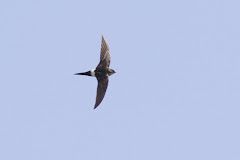For those of you who can read Danish, the finder's account of the Pacific Swift can be seen here. Below is my (rough) translation.
====
As most will know, on Tuesday 15 June, Stig Kjaergaard Rasmussen found Denmark's first Pacific Swift. Those who know their Danish ornithological history will realise that it is not the first new species for Denmark that Stig has discovered. Back in 1976 Stig, together with Vagn Valentinussen and Knud Freisleben found Denmark's first White-throated Sparrow. It was found in the eastern part of Kongelunden forest and, with this new find, Stig has now found two new species for Denmark less than 2km apart. An achievement that should motivate all patch-birders to get out into the field.
Stig has sent the following account of the fantastic Pacific Swift find:
Tuesday 15 June I was, as so many times before, on a morning tour of the Klydesøen area on Vestamager. It was an overcast and cold summer day so, after 4 hours in the bird tower, I decided to pack it in and head for home. When I reached Hejresøen I looked at the birds there, and at the eastern end of the lake I began to count the House Martins that were foraging over the lake with Common Swifts.
Suddenly, just after 1100, it happened. One of the birds with a white rump was swift-sized with a forked tail - a large swift. I could discount White-rumped Swift on grounds of size and Little Swift on grounds of size and because of the tail shape. So which species was it? I could not remember whether there were - apart from Pacific Swift - other Asian swifts with this appearance.
I watched the bird for some minutes down to 20 metres distance, before losing it behind some trees. What should I do now? I was on the one hand very pleased about the observation, but also annoyed to stand alone with a rare bird - and without being able to prove the observation with photos. I rang Tim Andersen and told him about the sighting. Tim concluded it was a Pacific Swift and gave me the mobile number of Alex Buhring, who was nearby in the southern observation tower.
Ten minutes later Alex was there. We looked for the swift, and before long saw it at full speed foraging over the lake. I rang Tim again, who reported the bird on DOFCall (the Danish rare bird alert system).
After half an hour the first breathless birders arrived. Soon the first photographer arrived and took picture after picture. The bird performed very well. It behaved in the same way the whole time and foraged together with Common Swifts quickly over the lake, sometimes low over the water and sometimes higher or over the treetops on the lake's opposite side. Then it would disappear briefly behind the trees at the end of the lake before reappearing again. Once it flew over the dam off Hejresøen.
It repeated this all the time while more and more enthusiastic birders assembled. The chat was lively and the photographers let loose,
In the time I saw the bird, I noticed the following features: the Pacific Swift had a typical swift profile. It was the size of, or a touch larger than, a Common Swift with longer, relatively narrow and pointed wings. It looked slimmer, more lanky than Common Swift, maybe due to the longer and more pointed tail. The tail was more deeply forked than Common Swift which was especially obvious when the bird could be seen from above when foraging low over the water.
The upperparts looked completely black at first but later, with a little sun, rather more dark brown, except for a broad, rectangular white rump, with the white reaching down to the rump's sides.
The underparts were dark brown, lighter than the upperparts. A large grey-white, diffuse throat patch. The underside of the body was lightly scaled which could be seen in good light, when it was close by. The underside of the wings showed darker coverts than primaries.
After 3 and a half hours, the party ended at 1430, just as abruptly as it had began. Strong thunderstorms approached and the Pacific Swift, with the Common Swifts, headed south.
For me it was an extraordinary birding experience. I could be very satisfied with the bird, and the fact that over 100 birders got to see it. It was just a pity that more birders - including those from further afield - didn't arrive in time.
=====
Subscribe to:
Post Comments (Atom)






No comments:
Post a Comment